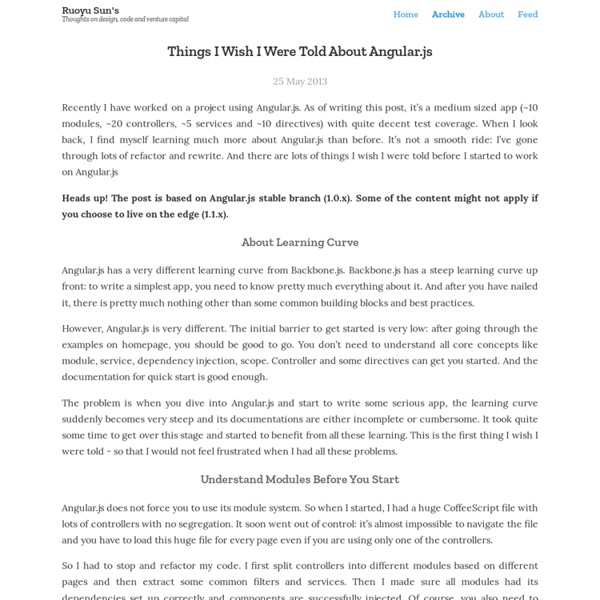Things I Wish I Were Told About Angular.js

Build Web Apps with AngularJS and Rails 4 - Thinkster
The goal of this tutorial is to guide you through the creation of a Reddit/Hacker News clone using Rails 4 and AngularJS. By completing this tutorial, you will gain a basic understanding of Rails and AngularJS, using Rails to build a JSON REST API that interacts with an AngularJS frontend. Prerequisites This course assumes knowledge of programming and at least basic knowledge of JavaScript and Ruby, and you should be comfortable with basic web application concepts including REST and CRUD. Recommendations for Completing this Tutorial Throughout the course of this tutorial, links to additional concepts and information will be included. We at Thinkster are firm believers in actually writing code. Project Specifications Before beginning work on any project, it's usually a good idea to know what you're building. Create new postsView all posts ordered by upvotesAdd comments about a given postView comments for a given postUpvote posts and commentsCreate a user authentication system using Devise
AngularJS Tutorial: Learn to Build Modern Web Apps with MEAN - Thinkster
The goal of this tutorial is to guide you through the creation of a Reddit/Hacker News clone using the MEAN stack. By completing this tutorial, you will gain a basic understanding of the MEAN stack including building a REST interface with Express.js on top of Node.js and using that interface to perform CRUD operations on a database via an AngularJS frontend. Why MEAN Stack? The acronym "MEAN" stands for "MongoDB Express.js AngularJS Node.js" and represents a group of technologies which are known to synergize well together. Prerequisites This course assumes knowledge of programming and at least basic knowledge of JavaScript. Recommendations for Completing this Tutorial Throughout the course of this tutorial, links to additional concepts and information will be included. We at Thinkster are firm believers in actually writing code. Project Specifications Before beginning work on any project, it's usually a good idea to know what you're building. Without further ado, let's jump in... if(! Recap
A Better Way to Learn AngularJS - Thinkster
Congratulations on taking the plunge! This AngularJS course is built with the intent of exposing you to the best available resources on each Angular topic. Our desire is to present these topics richly, and from a variety of vantage points, in order to afford you a more complete perspective on them. This course is accompanied by AngularJS Tutorial: Learn to Build Modern Web Apps with MEAN. The learning curve of AngularJS can be described as a hockey stick. Getting started with apps featuring basic functionality is delightfully easy. With AngularJS, the "Ready, Fire, Aim" learning methodology of duct taping together a handful of tutorials and a cursory glance through the documentation will lead to confusion and frustration. Prerequisites Resources Since AngularJS is still in its infancy relative to other JavaScript frameworks, the number of encyclopaedic resources on it is still insufficient. AngularJS is not a library. Filling the Tank Adjusting Your Mirrors Revving the Engine Readings $http
Things I have learned working with AngularJS | Código Vivo
You need to know its “core” very well. i.e. Dependency Injection, Double binding, Directives. I think of them as the three pillars of AngularJs Dependency Injection It´s the heart of angular used to organize the code in single units of functionality/responsibility and to make it Testable!!!! What is the minimum you should know? The Concept: What is IoC? Double Binding Angular double binding is one of the concepts that people get sooner but at the same time don´t really fully understand how to use it. Understand the reason behind it. Directives Directives are hard to build, to maintain and to some extend to test. Many people ask how can you build complex directives and In my opinion the best answer is Don´t build complex directives. I should clarify this a bit. Complex UI components should be seen as a set of directives and services that work together to bring the components’ functionality to work. Understand all the possible properties of a directives definition object. Unit Testing Updated
Building a Chat App with node-webkit, Firebase, and AngularJS
In this post we are going to build a desktop based chat application named vTak. We will use node-webkit to power the core desktop app and Firebase as our realtime data store. We will be using a slush generator named slush-wean to scaffold a basic node-webkit/Express/Angular app. The final product will look something like the following figure. Prerequistes If you are new to node-webkit, please refer to the following resources: Node Webkit – Build Desktop Apps with Node and Web TechnologiesNode Webkit powered Dashboard applicationNode webkit and Angularjs – A MovieStub App If you are new to Firebase, you should check out the following resources: Getting started with Firebase I would recommend using Sublime text while working with node-webkit apps. The Application Getting Started To build the application base, we are going to leverage a slush generator named slush-wean. Create a new folder named vTak and open a new terminal/prompt here. To scaffold the wean app, run slush wean. A quick overview:
Related:
Related:



